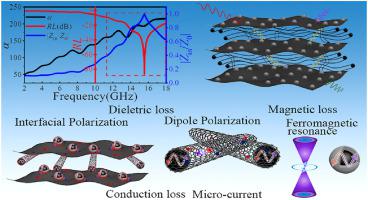Our official English website, www.x-mol.net, welcomes your
feedback! (Note: you will need to create a separate account there.)
Rational construction of hierarchical accordion-like Ni@porous carbon nanocomposites derived from metal-organic frameworks with enhanced microwave absorption
Carbon ( IF 10.5 ) Pub Date : 2020-10-01 , DOI: 10.1016/j.carbon.2020.06.015 Zhen Xiang , Chuang Huang , Yiming Song , Baiwen Deng , Xiang Zhang , Xiaojie Zhu , Dan Batalu , Oana Tutunaru , Wei Lu
Carbon ( IF 10.5 ) Pub Date : 2020-10-01 , DOI: 10.1016/j.carbon.2020.06.015 Zhen Xiang , Chuang Huang , Yiming Song , Baiwen Deng , Xiang Zhang , Xiaojie Zhu , Dan Batalu , Oana Tutunaru , Wei Lu

|
Abstract Development of high-performance microwave absorption materials with a thin matching thickness, wide effective absorption bandwidth, low filler loading, and strong absorption capacity has attracted extensive scientific and technological interest and it remains a huge challenge. Here, hierarchical accordion-like Ni@porous carbon (Ni@C) nanocomposites derived from metal-organic frameworks were rationally designed and successfully developed as enhanced microwave absorption materials. It was found that the well-tuned composition (Ni, C and CNTs) and structure (laminated, porous, and core-shell characteristics) of the resultant nanocomposites led to the variation of magnetic properties, graphitization degree, and electromagnetic parameters. As expected, the hierarchical accordion-like Ni@C nanocomposites with a low filler loading of 25 wt% achieved a broad effective absorption bandwidth of 6.6 GHz, a strong reflection loss of −86.9 dB with a thin thickness of 1.8 mm through the optimization of impedance matching and improvement of microwave attenuation ability. The enhanced microwave absorption was attributed to the loss synergistic effect between abundant interfacial and dipole polarization in the hierarchical architecture, to the electronic transport in the three-dimensional conductive network, and to strong magnetic coupling in Ni nanoparticles. Therefore, this work presented a tailored strategy for the development of novel hierarchical nanocomposites as enhanced microwave absorption materials.
中文翻译:

具有增强微波吸收的金属-有机骨架衍生的分层手风琴状Ni@多孔碳纳米复合材料的合理构建
摘要 开发匹配厚度薄、有效吸收带宽宽、填充量低、吸收能力强的高性能微波吸收材料引起了广泛的科技兴趣,但仍是一个巨大的挑战。在这里,来自金属有机骨架的分层手风琴状 Ni@多孔碳(Ni@C)纳米复合材料被合理设计并成功开发为增强型微波吸收材料。结果表明,所得纳米复合材料的组成(Ni、C 和 CNTs)和结构(层状、多孔和核壳特性)的良好调整导致了磁性、石墨化程度和电磁参数的变化。正如预期的那样,通过优化阻抗匹配和 1.8 mm 的薄厚度,具有 25 wt% 低填料负载的分层式手风琴状 Ni@C 纳米复合材料实现了 6.6 GHz 的宽有效吸收带宽,-86.9 dB 的强反射损耗和提高微波衰减能力。增强的微波吸收归因于分层结构中丰富的界面极化和偶极极化之间的损失协同效应、三维导电网络中的电子传输以及镍纳米颗粒中的强磁耦合。因此,这项工作提出了一种开发新型分层纳米复合材料作为增强微波吸收材料的定制策略。通过阻抗匹配的优化和微波衰减能力的提高,1.8mm的薄厚度达到9dB。增强的微波吸收归因于分层结构中丰富的界面极化和偶极极化之间的损失协同效应、三维导电网络中的电子传输以及镍纳米颗粒中的强磁耦合。因此,这项工作提出了一种开发新型分层纳米复合材料作为增强微波吸收材料的定制策略。通过阻抗匹配的优化和微波衰减能力的提高,1.8mm的薄厚度达到9dB。增强的微波吸收归因于分层结构中丰富的界面极化和偶极极化之间的损失协同效应、三维导电网络中的电子传输以及镍纳米颗粒中的强磁耦合。因此,这项工作提出了一种开发新型分层纳米复合材料作为增强微波吸收材料的定制策略。增强的微波吸收归因于分层结构中丰富的界面极化和偶极极化之间的损失协同效应、三维导电网络中的电子传输以及镍纳米颗粒中的强磁耦合。因此,这项工作提出了一种开发新型分层纳米复合材料作为增强微波吸收材料的定制策略。增强的微波吸收归因于分层结构中丰富的界面极化和偶极极化之间的损失协同效应、三维导电网络中的电子传输以及镍纳米颗粒中的强磁耦合。因此,这项工作提出了一种开发新型分层纳米复合材料作为增强微波吸收材料的定制策略。
更新日期:2020-10-01
中文翻译:

具有增强微波吸收的金属-有机骨架衍生的分层手风琴状Ni@多孔碳纳米复合材料的合理构建
摘要 开发匹配厚度薄、有效吸收带宽宽、填充量低、吸收能力强的高性能微波吸收材料引起了广泛的科技兴趣,但仍是一个巨大的挑战。在这里,来自金属有机骨架的分层手风琴状 Ni@多孔碳(Ni@C)纳米复合材料被合理设计并成功开发为增强型微波吸收材料。结果表明,所得纳米复合材料的组成(Ni、C 和 CNTs)和结构(层状、多孔和核壳特性)的良好调整导致了磁性、石墨化程度和电磁参数的变化。正如预期的那样,通过优化阻抗匹配和 1.8 mm 的薄厚度,具有 25 wt% 低填料负载的分层式手风琴状 Ni@C 纳米复合材料实现了 6.6 GHz 的宽有效吸收带宽,-86.9 dB 的强反射损耗和提高微波衰减能力。增强的微波吸收归因于分层结构中丰富的界面极化和偶极极化之间的损失协同效应、三维导电网络中的电子传输以及镍纳米颗粒中的强磁耦合。因此,这项工作提出了一种开发新型分层纳米复合材料作为增强微波吸收材料的定制策略。通过阻抗匹配的优化和微波衰减能力的提高,1.8mm的薄厚度达到9dB。增强的微波吸收归因于分层结构中丰富的界面极化和偶极极化之间的损失协同效应、三维导电网络中的电子传输以及镍纳米颗粒中的强磁耦合。因此,这项工作提出了一种开发新型分层纳米复合材料作为增强微波吸收材料的定制策略。通过阻抗匹配的优化和微波衰减能力的提高,1.8mm的薄厚度达到9dB。增强的微波吸收归因于分层结构中丰富的界面极化和偶极极化之间的损失协同效应、三维导电网络中的电子传输以及镍纳米颗粒中的强磁耦合。因此,这项工作提出了一种开发新型分层纳米复合材料作为增强微波吸收材料的定制策略。增强的微波吸收归因于分层结构中丰富的界面极化和偶极极化之间的损失协同效应、三维导电网络中的电子传输以及镍纳米颗粒中的强磁耦合。因此,这项工作提出了一种开发新型分层纳米复合材料作为增强微波吸收材料的定制策略。增强的微波吸收归因于分层结构中丰富的界面极化和偶极极化之间的损失协同效应、三维导电网络中的电子传输以及镍纳米颗粒中的强磁耦合。因此,这项工作提出了一种开发新型分层纳米复合材料作为增强微波吸收材料的定制策略。











































 京公网安备 11010802027423号
京公网安备 11010802027423号